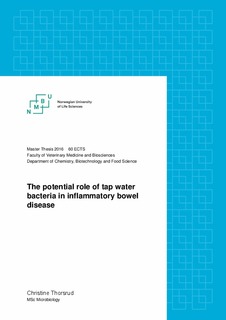| dc.contributor.advisor | Rudi, Knut | |
| dc.contributor.author | Thorsrud, Christine | |
| dc.date.accessioned | 2016-08-10T08:27:26Z | |
| dc.date.available | 2016-08-10T08:27:26Z | |
| dc.date.issued | 2016-08-10 | |
| dc.identifier.uri | http://hdl.handle.net/11250/2398588 | |
| dc.description.abstract | Microbial dysbiosis is implicated to play a substantial part in several pathophysiological
processes, and one disease receiving great attention in recent years owing to its affiliation
with an abnormal microbial state of the gut is inflammatory bowel disease. Being a
multifactorial disease, other factors implicated to contribute to its commence include genetics,
components of the immune system and environmental factors. Albeit suggestions of tap water
serving as an environmental trigger in the aetiology of IBD has been made, its potential
impact on the gastrointestinal microbiota remains an untouched area of investigation. Thus, in
this study we sought to investigate associations of tap water on the microbiota of
gastrointestinal mucosa that could substantiate research conducted to unveil environmental
and microbial factors contributing to the onset and/or maintenance of this disease. A total of
426 biopsies and 227 water samples retrieved from 129 and 223 patients respectively, served
as material for analysis, and included both adult and pediatric patients from Norwegian IBD
and control cohorts. The V3-V4 region of the 16S ribosomal ribonucleic acid gene was
amplified using a nested approached to polymerase chain reaction, and sequenced by use of
the Illumina MiSeq sequencing platform. Our findings exposed significant associations
between tap water and biopsies with respect to an operational taxonomic unit belonging to
Enterobacteriaceae at a p-value of 0,016 using Fisher exact as statistical approach. We further
disclosed highly significant increases of the same OTU in pediatric IBD sufferers, especially
in the ulcerative colitis cohort compared to cohorts of both age groups. This gave a p-value
<0,05 when pairwise comparisons with the Conover-Inman method was employed on the
median percentagewise prevalence of this OTU. Further analysis by Conover-Inman test also
revealed augmented levels of this OTU in biopsies of inflamed origin compared to biopsies of
normal state at a p-value of 0,000. Thus, our results serve as important contributors to
research on the environmental aspects of IBD, and also with respect to the role of
Enterobacteriaceae as a potential microbial key player in the onset and/or maintenance of this
disease. | nb_NO |
| dc.description.abstract | Mikrobiell dysbiose er implisert å spille en vesentlig rolle i flere patofysiologiske prosesser,
og en sykdom som de senere år har mottatt stor oppmerksomhet på grunn av sin assosiasjon
med anormale mikrobielle forhold i tarmen er inflammatorisk tarmsykdom. Som en
multifaktoriell sykdom, antas det at også genetikk, immunologiske komponenter og
miljøpåvirkninger medvirker til dens oppblomstring. På tross av forslag om drikkevann som
en mulig miljøtrigger i etiologien av IBD, er dens påvirkning på gastrointestinal mikrobiota
forblitt et relativt urørt forskningsområde. Derfor ønsket vi i denne studien å undersøke
sammenhenger mellom drikkevann og den gastrointestinale mikrobiotaen i mukosa, og bidra
med avdekkingen av miljømessige og mikrobielle faktorer som kan medvirke til
oppblomstringen og/eller opprettholdelsen av denne sykdommen. Totalt 426 biopsier og 227
vannprøver fra 129 og 223 pasienter ble benyttet som analysemateriale og inkluderte prøver
fra både voksne og barn fra en norsk IBD og kontroll kohort. V3-V4 regionen av 16S rRNA
genet ble amplifisert ved å bruke en nestet tilnærming til polymerase kjedereaksjon, og
sekvensert ved å bruke Illumina MiSeq som sekvensplattform. Vi avdekket signifikante
sammenhenger mellom drikkevann og biopsier når det kom til en operasjonell taksonomisk
enhet tilhørende Enterobacteriaceae med en p-verdi på 0,016 når Fisher exact ble benyttet
som statistisk tilnærming. Vi fant og signifikante økninger av den samme OTUen i barn med
IBD, da spesielt i ulcerøs kolitt kohorten sammenlignet med kohorter av begge aldersgrupper.
Dette viste en p-verdi <0,05 når parvise sammenligninger med Conover-Inman av medianen
av denne OTUens prosentvis prevalens ble benyttet. Videre analyse med Conover-Inman
avdekket og økte mengder av denne OTUen i inflammert vev sammenlignet med normalt vev
med en p-verdi på 0,000. Våre resultater utgjør dermed viktige bidrag i forskningen på det
miljømessige aspektet av IBD, og også i forskning som omhandler Enterobacteriaceae som
en potensiell nøkkelbakterie i oppblomstringen og/eller opprettholdelsen av denne
sykdommen. | nb_NO |
| dc.language.iso | eng | nb_NO |
| dc.publisher | Norwegian University of Life Sciences, Ås | |
| dc.title | The potential role of tap water bacteria in inflammatory bowel disease | nb_NO |
| dc.type | Master thesis | nb_NO |
| dc.subject.nsi | VDP::Mathematics and natural science: 400 | nb_NO |
| dc.source.pagenumber | 148 | nb_NO |
| dc.description.localcode | M-MB | nb_NO |
